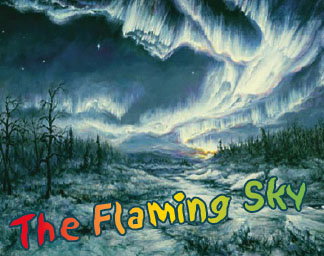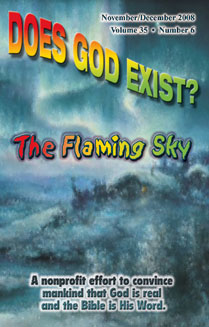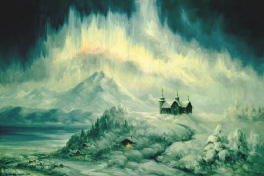

 The picture on the cover of our journal for this month
is a painting by the famous Alaskan artist Norman Lowell. Norman
has lived in Alaska most of his adult life, and his studio in Anchor
Point is filled with incredible paintings of the natural beauty of this
unique state. (For more information on Norman Lowell, contact
Lowell Studios & Galleries, P.O. Box 167, Anchor Point, AK 99556,
phone 907-235-7344.)
The picture on the cover of our journal for this month
is a painting by the famous Alaskan artist Norman Lowell. Norman
has lived in Alaska most of his adult life, and his studio in Anchor
Point is filled with incredible paintings of the natural beauty of this
unique state. (For more information on Norman Lowell, contact
Lowell Studios & Galleries, P.O. Box 167, Anchor Point, AK 99556,
phone 907-235-7344.)
We have been to Alaska many times, and have on occasion been able to watch the northern lights. In our home city of Niles, Michigan, we occasionally see the auroras--but nothing like what we have seen in Alaska. The northern lights can be ropes of color twisting through the skies, or waterfalls of moving and changing colors. On a few special occasions there has even been a sound that seemed to be coming from the sky--a hissing crackling sound somewhat like we hear with static electricity. The most common auroras, however, are like curtains hanging for hours near the horizon. Throughout the centuries these light shows have been badly misunderstood. Ancient peoples thought the earth was hollow and that the auroras were flames escaping from the depths of hell. Roman armies marched through a whole night to go toward what their leaders thought was a forest fire. UFO and alien promoters have used localized auroras to justify their claims of alien visitation to the earth.
We know a great deal about the auroras now thanks to research and study. We also have learned some interesting things about the sun and outer space as we have studied the northern lights. You can produce auroras in your home by just turning on a fluorescent light. When gas molecules are exposed to energy, their electrons are caused to change the orbital positions and usually light is emitted when such a change takes place. Different gases will give off different colors because they have different electron levels and different electrons changing their orbital position within those levels. A low energy change in an electron will emit red light. A high energy electron change in position will be blue or violet--a higher form of radiation. A red sign in a business establishment will be neon gas which emits low energy light rays when electron changes are made in it. A blue fluorescent light will have a high energy electron transfer taking place. In fluorescent lights, the energy which triggers these changes comes from a transformer that generates large electrical voltages.
In auroras the energy that causes the electrons to give off light comes primarily from the sun, but also from cosmic rays generated in outer space from other stars, galaxies, and nebulae. In the early days of research it was not clear why such energetic sources were in space, but we now know it is due to the nature of the sun and stars. Our sun is not just a big hot ball in the sky. We know that the sun has some major requirements in order for it to be able to sustain life on earth. Not only must the sun be hot enough to allow water to exist in the liquid state but it must be cold enough not to vaporize everything. In order for plants to have the right kinds of light to be able to carry on photosynthesis, the sun has to have certain energies of light which it emits. There are chemical reactions in the atmosphere of the earth that depend on solar radiation to make them work. In the process of satisfying all of these needs, the nuclear processes of the sun generate particles that would be harmful to life on earth.
These particles are deflected away from the earth by the earth's magnetic field. When they get low enough in our atmosphere they ionize gases within our atmosphere making the glow, and these glowing curtains of atoms are the auroras we see. Our studies of the sun have shown us it is a truly remarkable furnace made of its own fuel that has functioned for a very long time, and could go for another billion years without significant depletion of its hydrogen fuel. As we have studied the auroras, we have seen that God has designed several shields which protect us from these negative by-products of the solar reactions. We not only have a magnetic field which protects us, but we have an atmosphere made of various layers and each layer has a specific role which makes life on this planet possible.
The northern and southern lights remind us of how special our planet is, and how unique the star is that our planet orbits. Our studies of extra-solar planetary systems (planets orbiting stars other than our sun) have reinforced the unique nature of our planetary system. The psalmist's statement, "The heavens declare the glory of God and the earth shows his handiwork," takes on new meaning as we improve our ability to understand just how complex and highly designed the system is.

Back to Contents Does God Exist?, NovDec08.